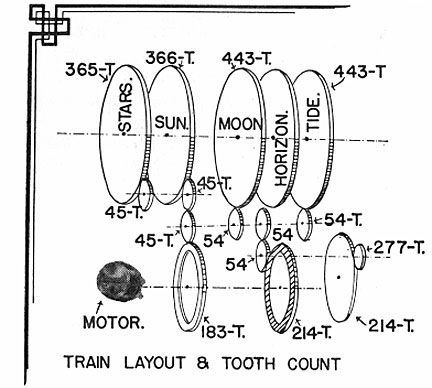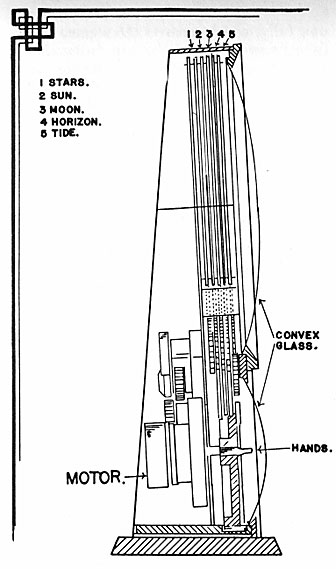Spilhaus Clock Construction Explained
The Best Of J.E. Coleman: Clockmaker
The Best Of J.E. Coleman: Clockmaker is a book that answers many questions about clocks. It contained a wonderful description of the Spilhaus Space Clock from a gear train and construction perspective. However covered the Nylon gears and repair lightly if incorrectly.

TRAIN LAYOUT 8 TOOTH COUNT
The large dial at the top is 8 5/8 inches diameter; is in fact literally five dials, transparent and mounted concentrically. From it you get 15 readings:
- The Horizon and the visible heavens.
- The sun’s position in the sky.
- The moon’s position.
- Position of the stars.
- Relative position of the sun, moon and stars.
- Day of the month and year (s perpetual calendar).
- Solar time of sun, moon and stars at meridian.
- Star or sidereal time (for use with astronomical tables).
- Current phase of the moon.
- Time of daily sunrise and sunset.
- Mean time of moon rise and moon set.
- Mean time of star rise and star set.
- Current time high or low tide.
- Current stages of the tides.
- Mean solar time.
Below the large dial are two four inch dials. The dial on the left records local standard time. The right dial, records 24-hour time, and the time in principal cities of the world -the dark half-circle border on the outer circumference indicates that part of the world is in darkness. And, the white radii, indicating the individual cities, remain stationary as the 24 hour ring moves. The various continent land masses are a vivid gold on a blue field and are highly visible.

The clock stands approximately 16 inches high; its base is 11% by five inches-to better illustrate the working of this clock here is rough sketch of its cross section:
The five transparent discs, numbered one to five, are of Plexiglass. It will be noted from the train layout sketch that only the horizon disc does not turn. The rotating discs are mounted in Teflon guides for free low friction movement. Running in guides all cent er mounting is eliminated, thereby leaving the entire disc free of obstruction for viewing through to the next, etc. No. 2, the Sun disc, has additional play in its guides to allow lifting it out of mesh for setting purposes; friction-setting is provided in appropriate manner for the other indicators
The 'standard' clock is powered by a heavy duty, AC-110-V. 60 cycle) synchronous clock motor (“Synchron” by Hansen of Princeton, Ind.) straight through as indicated upon the cross section. 'The 4-inch World time dial at the right and the 8 5/8 inch dials at the top are driven by the same power via idler gearings of correct toothage for ultimate accurate readings as shown in the train layout.
Repair wise, complicated as it seems, there isn't much indication for 'service' barring a wreck or accident; running in Teflon guides,
lubrication in not necessary; the bench repairman is already familiar with the Hansen “Synchron” motor and/or its replacement when necessary . Edmund Scientific Co. will supply needed parts on direct order, when needed. All in all, this is a delightful clock as it is. It will be referred to as the “standard” model; just now getting into real production there hasn't’t been time for further elaboration, however, a different drive power such as a spring-wound or battery (transistor) power has already been mentioned for use where regulated synchronous current is not available, such as upon a boat, etc., - so has interior illumination plus various other additives that always suggest themselves for new pieces.
